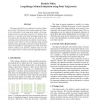Free Online Productivity Tools
i2Speak
i2Symbol
i2OCR
iTex2Img
iWeb2Print
iWeb2Shot
i2Type
iPdf2Split
iPdf2Merge
i2Bopomofo
i2Arabic
i2Style
i2Image
i2PDF
iLatex2Rtf
Sci2ools
CVPR
2006
IEEE
2006
IEEE
Particle Video: Long-Range Motion Estimation using Point Trajectories
This paper describes a new approach to motion estimation in video. We represent video motion using a set of particles. Each particle is an image point sample with a longduration trajectory and other properties. To optimize these particles, we measure point-based matching along the particle trajectories and distortion between the particles. The resulting motion representation is useful for a variety of applications and cannot be directly obtained using existing methods such as optical flow or feature tracking. We demonstrate the algorithm on challenging real-world videos that include complex scene geometry, multiple types of occlusion, regions with low texture, and non-rigid deformations.
| Added | 10 Jun 2010 |
| Updated | 10 Jun 2010 |
| Type | Conference |
| Year | 2006 |
| Where | CVPR |
| Authors | Peter Sand, Seth J. Teller |
Comments (0)

